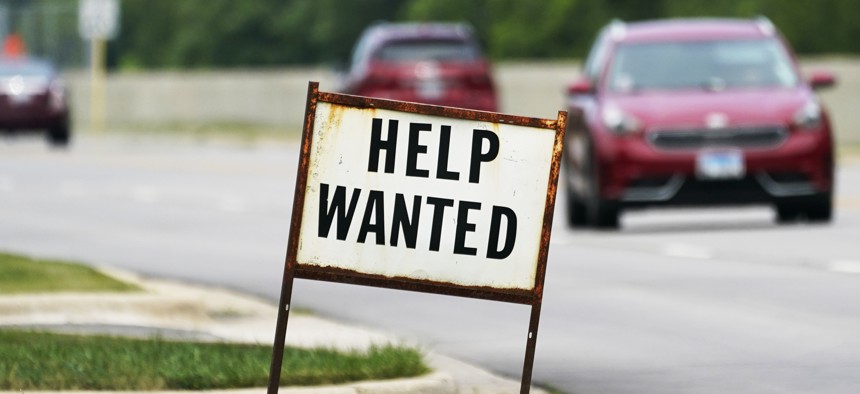States Can Pay Enhanced Unemployment Beyond Cut Off with ARPA Funds

A help wanted sign is displayed at a gas station in Mount Prospect, Ill., Tuesday, July 27, 2021. AP Photo/Nam Y. Huh
Extra federal benefits end Sept. 6, but Biden administration officials said using some of the federal relief dollars will allow for a more gradual wind down.
The federal government will stop paying enhanced unemployment benefits on Labor Day.
But states that want to continue providing additional support to unemployed workers can use money allocated through the American Rescue Plan Act, according to Labor and Treasury department officials.
About 11 million people are receiving unemployment benefits, according to the most recent Department or Labor data. But most of those people stand to lose benefits completely or see weekly payments cut by $300 when benefits expire Sept. 6.
To allow for a more gradual wind down of unemployment benefits, the Biden administration is encouraging states to use some of the $350 billion in state and local funding allocated through ARPA to continue those payments as necessary.
The money can be used to “provide assistance to unemployed workers, including by continuing to provide additional weeks of income support to workers whose benefits expire on September 6th and to workers outside of regular state UI programs,” wrote Treasury Secretary Janet Yellen and Labor Secretary Martin Walsh in a letter sent last week to members of Congress.
The Department of Labor plans to work with states to provide guidance on how they utilize ARPA funding through existing unemployment insurance systems.
“This will enable states that choose to do so to more seamlessly provide support to unemployed workers, while complying with existing federal law and regulations,” Yellen and Walsh wrote.
The Sept. 6 cutoff has the potential to be “the largest cutoff of unemployment benefits in history,” according to Andrew Stettner, a senior fellow at the Century Foundation.
Among those who will lose enhanced benefits on Labor Day are the approximately 4.8 million people receiving Pandemic Unemployment Assistance benefits, which provided financial support to the self-employed and gig workers for the first time. Another 3.7 million people are receiving Pandemic Emergency Unemployment Compensation benefits, which supplements the weekly state unemployment benefits $300.
“The U.S. economy is recovering from the deep wound of the pandemic jobs crisis, but millions of workers are still unemployed,” Stettner wrote. “Because unemployment benefit levels vary greatly from state to state, the ending of federal benefits will have a far greater impact where traditional state benefit levels are the lowest.”
It's unclear how many states will seek to use ARPA funding to continue enhanced unemployment payments. At least 22 states borrowed money from the federal government just to keep their unemployment trust funds solvent during the coronavirus pandemic. Fifteen states still need to repay more than $54 billion in borrowed funds.
Many Republican-controlled states cut off access to enhanced unemployment benefits early, citing concern that people were returning to work because they could make more by staying home. At the end of July, the enhanced benefits were only available in nine states —Alaska, California, Connecticut, Illinois, Nevada, New Jersey, New Mexico, New York, and Texas— and Washington, D.C.
But lawsuits brought by workers have forced several states to resume payments.
The national unemployment rate stands at 5.4%. Thirteen states and Washington, D.C. reported higher unemployment rates last week—Nevada had the highest rate at 7.7%.
Andrea Noble is a staff correspondent with Route Fifty.
NEXT STORY: States Turn to Recruiting and Retention Bonuses for Police





